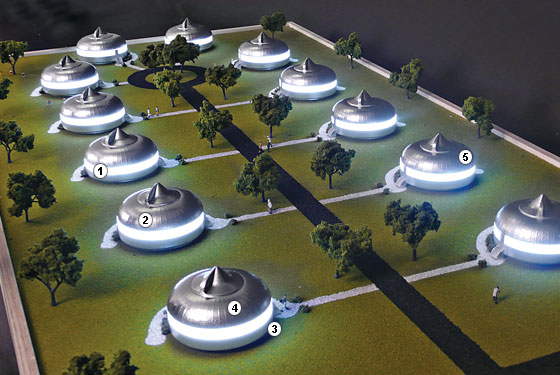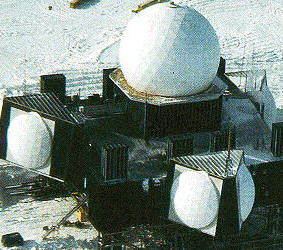
R.
Buckminster Fuller and Systems Theory

2004 stamp commemorating Buckminster Fuller1i
In addition to being a successful architect and inventor, R Buckminster Fuller was also known as a systems philosopher. He used the phrase “Spaceship Earth” to express the need for mankind to use teamwork to fully utilize Earth’s limited resources.1 Ephemeralization was another systems’ term coined by Fuller to express the concept of accomplishing more with fewer resources.2 His third system philosophy is Synergetics which is an attempt to combine various scientific disciplines to describe the energy output of an overall system exceeding the output from individual parts of a system.3
Spaceship
Earth is Fuller’s concept of doing more with less and being able to
spread
limited resources on the planet to satisfy the growing population. Fuller’s was expelled from
Harvard in 1914,
attempted to and eventually succeeded in joining the Navy from which he
was honorably
discharged in August 1919. Inspired
by
his experience in the Navy, he felt that men should be in service to
humanity
and spent most of his life devoted to that service.
He felt that economic profiteering after the
war was ruining man’s connection to the Human Family and that man
should be in
service of the public as sailors labour for a common cause. The philosophy of Thomas
Malthus was popular
at the time promoting the idea that as populations grew, the food
supply would
decrease leading to disaster. Fuller
felt this philosophy was wrong in that it only looked at things from an
economic standpoint and didn’t factor in scientific advancement. He felt like Henry Ford’s
assembly line,
engineering could be used to solve the problem of finite resources to
accommodate the growing population. 4
Another
aspect of Fuller’s Spaceship Earth philosophy is the concept of ecology
and utilitarian
philosophy. He had
this concept in mind
when he developed the Dymaxion House in the 1930’s.
Dynamic, maximum, and ion were placed
together to form the word Dymaxion.
He
named several inventions under this brand name such as a Dymaxion car,
Dymaxion
House, and other structures. The Dymaxion
House could be put up in less than 24 hours.
The
roof was designed to utilize the dome effect which ventilated hot air
out and forced cooler air downward creating natural air conditioning.4
The
house also used packaging toilets which would package waste for
composting. The bathroom was a one piece prefabricated unit
with
fogging shower heads to conserve water. The fogging
showerhead
used compressed air and water instead of exclusively water.

Example of neighborhood with Dymaxion houses3i

View of the interior of a Dymaxion House4i
Several Dymaxion Houses were bought by the military leading into World War II which led Fuller to design his first dome structures which were also purchased by the military since they were lightweight and easy to construct and could be adjusted to suit a client’s needs. Many of these domes where used on military bases including the Distant Early Warning Line near the Arctic Circle which were a series of radar stations built for surveillance during the Cold War. These domes where lightweight and could be built and carried by helicopter to a military base's location.5

DEW
line radar station featuring Fuller's dome design5i
Fuller also developed a Dymaxion car in 1933 which was a 3 wheeled car designed for 11 passengers.12 The steering was provided by the pivoting rear wheel with a Ford V8 engine getting 30 miles to the gallon. Fuller said the top speed could go 120 mph, but it only had a top documented speed of 90 mph. During the 1933 World's Fair, an accident occurred in which the car overturned killing the driver and seriously injuring the 2 passengers. Because of this accident, the car was never put into production.13
Click to see a YouTube video of the Dymaxion car
Contributing
to his Spaceship Earth philosophy was Buckminster Fuller’s development
of
polyhedron cuboctahedron map of the world which was a cutout in one of
the most
popular issues of Life Magazine.6
Users were allowed to visualize the Earth as one spaceship
in the air
age which would soon lead to the space age.
Much of the mathematics and design principals used in this
map would
lead to Fuller’s development of the geodesic domes.
The map and the domes exemplified his
principles of the sum being greater than the parts and using
engineering to
maximize the end product with minimal materials.
During
the early 60’s, Fuller did a significant amount of travelling and
lecturing on
the impact of the growing population and how to satisfy its needs. This
allowed him to experience different
cultures and see things from a global perspective.
Writing in 1963, Fuller stated, “One third of
the human family is now doomed to premature death due to causes arising
directly from inadequate solution to the housing problem.”6 Buckminster Fuller, himself
provided solutions
this problem with his dymaxion homes and felt designers and scientist
in the
future would provide solutions to satisfying the needs of the
increasing
population with finite resources.
Around
this
time, Fuller and other public figures made reference to “Spaceship
Earth” and
began to theorize about structuring the Earth’s societies in an orderly
fashion
such as astronauts on an idealized space colony.
In his book Operating Manual for
Spaceship Earth, Fuller wrote “Man is going to
be displaced
altogether as a specialist by the computer.”
He envisioned a master computer with all knowledge and
felt the
designers and scientists were the only competent group to lead
Spaceship Earth
and the human family. He
wrote, “So,
planners, architects, and engineers take the initiative. Go to work.”7
Fuller
taught “World Planning” while teaching at the Southern Illinois
University. He
encouraged students
through a multidiscipline approach.
“The design scientist would not be concerned exclusively
with the seat
of a tractor but [with] the whole concept of production and
distribution of
food”, Fuller wrote.8
He
proposed several miniature Earths which
mapped out areas of high population and encouraged thinking towards
efficiently
satisfying the needs of those areas.
He
also created a “World Game” where groups would tackle individual
problems such
as a lacking resource and discuss how to fulfill the needs of the
population. These
simulations led to thinking globally
and enforcing the concept of earth as a Spaceship.
It also enforced Fuller’s belief that
“Malthusian philosophy is fallacious”9 and that
human creativity and
innovation could solve the world’s increasing population problem.
Fuller’s popularizing a global view and emphasis on allocating resources, many of which are natural, helped to inspire the fledgling environmental movement in the 60’s. Some environmentalist felt that the same as Fuller that new technologies would allow the needs of the growing population to be satisfied while other environmentalist felt that the existing resources should be used more efficiently instead of hoping for new technologies to come along. Although Fuller’s geodesic domes and inventions aren’t as popular as they were during the Cold War, the concept of Spaceship Earth continue to impact the current age especially the global consciousness due largely to the internet and communication technology, using limited resources to satisfy an ever expanding population, and developing technology in harmony with nature.
Ephemeralization is the term coined by Fuller to express the drive to use less material for greater results such as for housing and his geodesic domes. Fuller developed this philosophy partly in reaction to the philosophy of Thomas Malthus. Thomas Malthus felt that the finite resources of planet earth coupled with the increase of human population would eventually result in a running out of resources for the human race. Buckminster Fuller disagreed and felt that technology, improved design, and engineering would help to allow mankind to use the existing resources more efficiently causing greater output with decreased input. His goal was to do "more and more with less and less until eventually you can do everything with nothing."2 He looked to Henry Ford’s assembly line as an example of ephemeralization where efficient design was used to increase productivity. Generally, technology increases ephemeralization such as the steam ship replacing wooden sailing ships allowing for faster sea travel. Computers and computing power is also an example of ephemeralization. Based on Moore's Law (named after Intel founder Gordon E. Moore), the number of transistor's on an integrated circuit doubles every two years.13 As a result, computers that used to take up entire rooms have gotten progressively smaller over the past few decades. In spite of speculation that Moore's Law may have reached it's physical limits14, designers and engineers continue to find ways to increase computing power enforcing the principle of ephemeralization.15
"Synergetics is the system of holistic thinking which R. Buckminster Fuller introduced and began to formulate. Synergetics is multi-faceted: it involves geometric modeling, exploring inter-relationships in the facts of experience and the process of thinking. Synergetics endeavors to identify and understand the methods that Nature actually uses in coordinating Universe (both physically and metaphysically). Synergetics provides a method and a philosophy for problem-solving and design and therefore has applications in all areas of human endeavor."
- Synergetics Collaborative16
"101.01 Synergy means behavior of whole systems unpredicted by the behavior of their parts taken separately.
102.00 Synergy means behavior of integral, aggregate, whole systems unpredicted by behaviors of any of their components or subassemblies of their components taken separately from the whole.
962.40 Synergetic geometry embraces all the qualities of
experience, all aspects of being."
- R. Buckminster Fuller, Synergetics17
Like other Fuller concepts, Synergetics
is interested in the production of the machine as a whole and not the
individual parts. He wanted to maximize the output of the
Spaceship Earth for the benefit of humanity. He explained
this largely through geometry and geometric structures.
Synergetics is wide ranging study utilizing expertise in various
sciences and
arts such as thermodynamics, chemistry, psychology, biochemistry,
economics, philosophy and theology. Fuller outlined his
philosophy in his 2 volume book Synergetics in collaboration with E. J.
Applewhite. Looking at Fuller's dome structures, smaller
geometric shapes are used as building blocks for the main structure.
For example, triangles within the greater shape of his geodesic
domes.
I think these concepts are easier to understand visually
rather than reading a textual explanation. So, the following
images and links show some of Fuller's work using his principles of
Synergetics.
http://www.youtube.com/playlist?list=PL9BA8514D47350892
http://www.youtube.com/embed/hEyuv3Hfh6I
1949 Autonomous Living Unit.8i

Montreal Biosphere designed by Buckminster Fuller for the 1967 Montreal Expo.9i


Spaceship Earth at Disney's Epcot Center inspired by Buckminster Fuller.9i
References
1. Fuller, Buckminster (1963). Operating Manual for Spaceship Earth. (New York: E.P. Dutton & Co., 1963), 1.4.
2. R. Buckminster Fuller, Nine Chains to the Moon, (Anchor Books [1938] 1971) pp. 252–59.
3. Synergetics, http://www.rwgrayprojects.com/synergetics/synergetics.html
4. Peder Anker, Frank Lloyd Wright, ‘Buckminster Fuller as Captain of Spaceship Earth’, Minerva, Volume 45, Issue 4 (December 2007), 417-434.
5. Richard Buckminster Fuller, Ideas and Integrities, ed. by Robert Marks. (Englewood Cliffs: Prentice-Hall, 1963), 96.
6. Anonymous, ‘R. Buckminster Fuller’s Dymaxian World’, Life, 1 March 1943, 40–55.
7. Richard Buckminster Fuller, Ideas and Integrities, ed. by Robert Marks (Englewood Cliffs: Prentice-Hall, 1963), 187.
8. Fuller, Operating Manual for Spaceship Earth, (New York: E.P. Dutton & Co. 1963). 44, 133.
9.
Richard
Buckminster Fuller, Utopia or Oblivion
(New York: Overlook, 1969), 293.
10.
Edwin
Schlossberg quoted in Richard Buckminster
Fuller et al., World Game Report
(New
York: New York Studio School, 1969), Note 37, 1.
11.
13. Moore, Gordon E. (1965). "Cramming more components onto integrated circuits". Electronics Magazine. p. 4. Retrieved 2006-11-11.
14. Kaku, Michio. "Parallel universes, the Matrix, and superintelligence". Kurzweil. Retrieved 2011-08-22.
15. Ray Kurzweil (2001-05-01). "The Law of Accelerating Returns". KurzweilAI.net. Retrieved 2006-06-24.
16. http://synergeticscollaborative.org/. Retreived 2013-11-02.
17. Fuller, Buckminster. Synergetics: Explorations in the Geometry of Thinking (Macmillan Publishing Co. Inc. 1975, 1979). 100.00 Synergy, 900.00 Modelability.